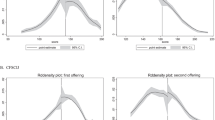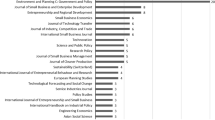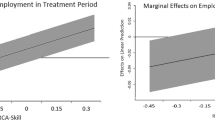Abstract
An assessment of the economic impact that can be achieved through grants makes it possible to refine such policy instruments in order to make public funding more effective in relation to the objectives pursued. In this paper, we investigate the effects of a business development grant scheme. More specifically, we question whether firms’ performance measures increased after receiving such grants. Methodically, we match grant receiving firms with grant non-receivers and estimate the average treatment effect on the treated using a two-way fixed effects regression. Our results point towards a positive effect of the grant scheme, which is particularly evident for firms of smaller size. Our estimated dose-response functions show that the share of grant amount in firm profits needs to be high enough for the grants to be effective. According to back-of-the envelope analysis, benefits outweigh the direct scheme costs.


Similar content being viewed by others
Notes
For a systematic literature review of non-R&D public grants impact evaluations, see Dvoulety, Srhoj and Pantea (2020).
Please note the change in the name of the Ministry. In the period, it was firstly Ministry of Economy, Labour and Entrepreneurship, then Ministry of Entrepreneurship and Crafts, and is currently (2018) part of the Ministry of Economy, Entrepreneurship and Crafts.
This grant scheme targeted industries like shipbuilding or textile, and therefore, many similar firms benefited from this scheme, which makes obtaining a good counterfactual particularly difficult.
Or about €3600.
Or between €3600 and €7400.
Caliper is set to default value 0.25.
All of these results are available from authors upon request.
References
Abadie, A., & Spiess, J. (2019). Robust post-matching inference. Harvard Working Papers, 561066, 1–33 https://scholar.harvard.edu/files/spiess/files/robust.pdf.
Angrist, J. D., & Pischke, J.-S. (2010). The credibility revolution in empirical economics: How better research design is taking the con out of econometrics. The Journal of Economic Perspectives, 24(2), 3–30. https://doi.org/10.1257/jep.24.2.3.
Arrow. (1962). Economic welfare and the allocation of resources for invention (pp. 609–626). In The Rate and Direction of Inventive Activity: Economic and Social Factors. Princeton University Press.
Beck, T., & Demirguc-Kunt, A. (2006). Small and medium-size enterprises: Access to finance as a growth constraint. Journal of Banking and Finance. https://doi.org/10.1016/j.jbankfin.2006.05.009.
Bertoni, F., Martí, J., & Reverte, C. (2019). The impact of government-supported participative loans on the growth of entrepreneurial ventures. Research Policy, 48(1), 371–384. https://doi.org/10.1016/j.respol.2018.09.006.
Biagi, F., Bondonio, D., & Martini, A. (2015). Counterfactual impact evaluation of enterprise support programmes. Evidence from a decade of subsidies to Italian firm. In 55th Congress of the European Regional Science Association, Lisbon (pp. 1–16). European Regional Science Association (ERSA). Retrieved from http://hdl.handle.net/10419/124844
Bondonio, D., & Greenbaum, R. T. (2014). Revitalizing regional economies through enterprise support policies: An impact evaluation of multiple instruments. European Urban and Regional Studies, 21(1), 79–103. https://doi.org/10.1177/0969776411432986.
Bronzini, R., & Piselli, P. (2016). The impact of R&D subsidies on firm innovation. Research Policy, 45(2), 442–457. https://doi.org/10.1016/j.respol.2015.10.008.
Burger, A., & Rojec, M. (2018). Impotence of crisis-motivated subsidization of Firms: The Case of Slovenia. Eastern European Economics. https://doi.org/10.1080/00128775.2017.1416294.
Castellani, D., & Fassio, C. (2019). From new imported inputs to new exported products. Firm-level evidence from Sweden. Research Policy. https://doi.org/10.1016/j.respol.2018.08.021.
Chabé-Ferret, S. (2017). Should We Combine Difference In Differences with Conditioning on Pre-Treatment Outcomes? (No. 17–824). Toulouse.
Clausen, T. H. (2009). Do subsidies have positive impacts on R&D and innovation activities at the firm level? Structural Change and Economic Dynamics, 20(4), 239–253. https://doi.org/10.1016/j.strueco.2009.09.004.
Coad, A., & Srhoj, S. (2019). Catching gazelles with a lasso. Big Data techniques for the prediction of high-growth firms. Small Business Economics, 1–25. https://doi.org/10.1007/s11187-019-00203-3.
Criscuolo, C., Martin, R., Overman, H. G., & Van Reenen, J. (2019). The causal effects of an industrial policy. American Economic Review., 109(1), 48–85. https://doi.org/10.1257/aer.20160034.
Czarnitzki, D., & Delanote, J. (2015). R&D policies for young SMEs: Input and output effects. Small Business Economics. https://doi.org/10.1007/s11187-015-9661-1.
Czarnitzki, D., & Lopes-Bento, C. (2013). Value for money? New microeconometric evidence on public R&D grants in Flanders. Research Policy, 42(1), 76–89. https://doi.org/10.1016/j.respol.2012.04.008.
Czarnitzki, D., Hottenrott, H., & Thorwarth, S. (2011). Industrial research versus development investment: The implications of financial constraints. Cambridge Journal of Economics. https://doi.org/10.1093/cje/beq038.
David, P. A., Hall, B. H., & Toole, A. A. (2000). Is public R&D a complement or substitute for private R & D? A review of the econometric evidence. Research Policy, 29(4), 497–529. https://doi.org/10.1016/S0048-7333(99)00087-6.
Dimos, C., & Pugh, G. (2016). The effectiveness of R&D subsidies: A meta-regression analysis of the evaluation literature. Research Policy, 45(4), 797–815. https://doi.org/10.1016/j.respol.2016.01.002.
Dvouletý, O., Srhoj, S., & Pantea, S. (2020). Public SME grants and firm performance in European Union: A systematic review of empirical evidence. Small Business Economics, 1–21. https://doi.org/10.1007/s11187-019-00306-x.
Freel, M., Liu, R., & Rammer, C. (2019). The export additionality of innovation policy. Industrial and Corporate Change, dty059. https://doi.org/10.1093/icc/dty059.
Graham, N., Arai, M., & Hagstromer, B. (2016). Multiwayvcov: Multi-way standard error clustering.
Hall, B. H., & Lerner, J. (2009). The financing of R & D and innovation. In Handbook of the Economics of Innovation (pp. 609–639). https://doi.org/10.1016/S0169-7218(10)01014-2.
Hall, B. H., & Maffioli, A. (2008). Evaluating the impact of technology development funds in emerging economies: Evidence from Latin America. The European Journal of Development Research, 20(2), 172–198. https://doi.org/10.1080/09578810802060819.
Ho, D. E., Imai, K., King, G., & Stuart, E. A. (2007). Matching as nonparametric preprocessing for reducing model dependence in parametric causal inference. Political Analysis, 15(3), 199–236. https://doi.org/10.1093/pan/mpl013.
Ho, D. E., Imai, K., King, G., & Stuart, E. A. (2011). MatchIt: Nonparametric preprocessing for parametric causal inference. Journal of Statistical Software, 42(8), 1–28.
Hottenrott, H., Lopes-Bento, C., & Veugelers, R. (2017). Direct and cross-scheme effects in a research and development. Research Policy, 46(6), 1118–1132. https://doi.org/10.1016/j.respol.2017.04.004.
Hottenrott, H., Lins, E., & Lutz, E. (2018). Public subsidies and new ventures’ use of bank loans. Economics of Innovation and New Technology, 27(8), 786–808. https://doi.org/10.1080/10438599.2017.1408200.
King, G., & Nielsen, R. (2016). Why propensity score should not be used for matching. Working Paper.
Klette, T. J., Moen, J., & Griliches, Z. (2000). Do subsidies to commercial R&D reduce market failures? Microeconomic evaluation studies. Research Policy, 29(4), 471–495. https://doi.org/10.3386/w6947.
Le, T., & Jaffe, A. B. (2017). The impact of R&D subsidy on innovation: Evidence from New Zealand firms. Economics of Innovation and New Technology, 26(5). https://doi.org/10.1080/10438599.2016.1213504.
Levinsohn, J., & Petrin, A. (2003). Estimating production functions using inputs to control for unobservables. The Review of Economic Studies, 70(2), 317–341 Retrieved from http://www.jstor.org/stable/3648636%0A.
Marino, M., Lhuillery, S., Parrotta, P., & Sala, D. (2016). Additionality or crowding-out? An overall evaluation of public R&D subsidy on private R&D expenditure. Research Policy, 45(9). https://doi.org/10.1016/j.respol.2016.04.009.
Martí, J., & Quas, A. (2018). A beacon in the night: Government certification of SMEs towards banks. Small Business Economics. https://doi.org/10.1007/s11187-016-9828-4.
McKenzie, D. (2017). Identifying and spurring high-growth entrepreneurship: Experimental evidence from a business plan competition. American Economic Review. https://doi.org/10.1257/aer.20151404.
Michalek, J., Ciaian, P., & Kancs, D. (2015). Investment crowding out: Firm-level evidence from northern Germany. Regional Studies, 50(9), 1579–1594. https://doi.org/10.1080/00343404.2015.1044957.
MINPO. (2012). Poduzetnički impuls - Plan poticanja poduzetništva i obrtništva. Government of the Republic of Croatia, Ministry of Entrepreneurship and Crafts.
Munch, J., & Schaur, G. (2018). The effect of export promotion on firm-level performance. American Economic Journal: Economic Policy. https://doi.org/10.1257/pol.20150410.
OECD. (2002). Frascati Manual: Proposed Standard Practice for Surveys on Research and Experimental Development. The Measurement of Scientific and Technological Activities. https://doi.org/10.1787/9789264199040-en.
OECD, ETF, EU, EBRD, & SEECEL. (2016). SME policy index: Western Balkans and Turkey 2016 assessing the implementation of the small business act for Europe. Paris. https://doi.org/10.1787/9789264254473-en.
OPPMSP. (2008). Operativni plan poticaja malog i srednjeg poduzetništva. Government of the Republic of Croatia, Ministry of Economy, Labour and Entrepreneurship.
Peric, M., & Vitezic, V. (2016). Impact of global economic crisis on firm growth. Small Business Economics, 46(1), 1–12. https://doi.org/10.1007/s11187-015-9671-z.
R Core Team. (2014). R Core Team (2014). R: A language and environment for statistical computing. R Foundation for Statistical Computing, Vienna, Austria. URL Http://Www.R-Project.Org/./S0103-64402004000300015.
Radosevic, S., & Yoruk, E. (2018). Technology upgrading of middle income economies: A new approach and results. Technological Forecasting and Social Change, 129, 56–75. https://doi.org/10.1016/j.techfore.2017.12.002.
Rodrik, D. (2008) Normalizing industrial policy. Commission on Growth and Development Working Paper No. 3.
Rostamkalaei, A., & Freel, M. (2016). The cost of growth: Small firms and the pricing of bank loans. Small Business Economics. https://doi.org/10.1007/s11187-015-9681-x.
Srhoj, S., & Walde, J. (2020). Getting ready for EU Single Market: The effect of export-oriented grant schemes on firm performance. Structural Change and Economic Dynamics, 52, 279–293. https://doi.org/10.1016/j.strueco.2019.11.001.
Srhoj, S., Škrinjarić, B., & Radas, S. (2019). Bidding against the odds? The impact evaluation of grants for young micro and small firms during the recession. Small Business Economics, 1–21. https://doi.org/10.1007/s11187-019-00200-6.
Stiglitz, J., & Weiss, A. (1981). Credit rationing in markets with imperfect information. The American Economic Review. https://www.jstor.org/stable/1802787.
van der Wal, W. M., & Geskus, R. B. (2011). Ipw: An R package for inverse probability weighting. Journal of Statistical Software, 43(13), 1–23.
Vos, E., Yeh, A. J. Y., Carter, S., & Tagg, S. (2007). The happy story of small business financing. Journal of Banking and Finance. https://doi.org/10.1016/j.jbankfin.2006.09.011.
Author information
Authors and Affiliations
Corresponding author
Additional information
Publisher’s note
Springer Nature remains neutral with regard to jurisdictional claims in published maps and institutional affiliations.
Electronic supplementary material
ESM 1
(DOCX 108 kb)
Rights and permissions
About this article
Cite this article
Srhoj, S., Lapinski, M. & Walde, J. Impact evaluation of business development grants on SME performance. Small Bus Econ 57, 1285–1301 (2021). https://doi.org/10.1007/s11187-020-00348-6
Accepted:
Published:
Issue Date:
DOI: https://doi.org/10.1007/s11187-020-00348-6
Keywords
- Business development grants
- Policy evaluation
- Two-way fixed effects regression
- Matching
- Heterogeneous treatment effects
- Dose-response-function




